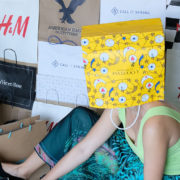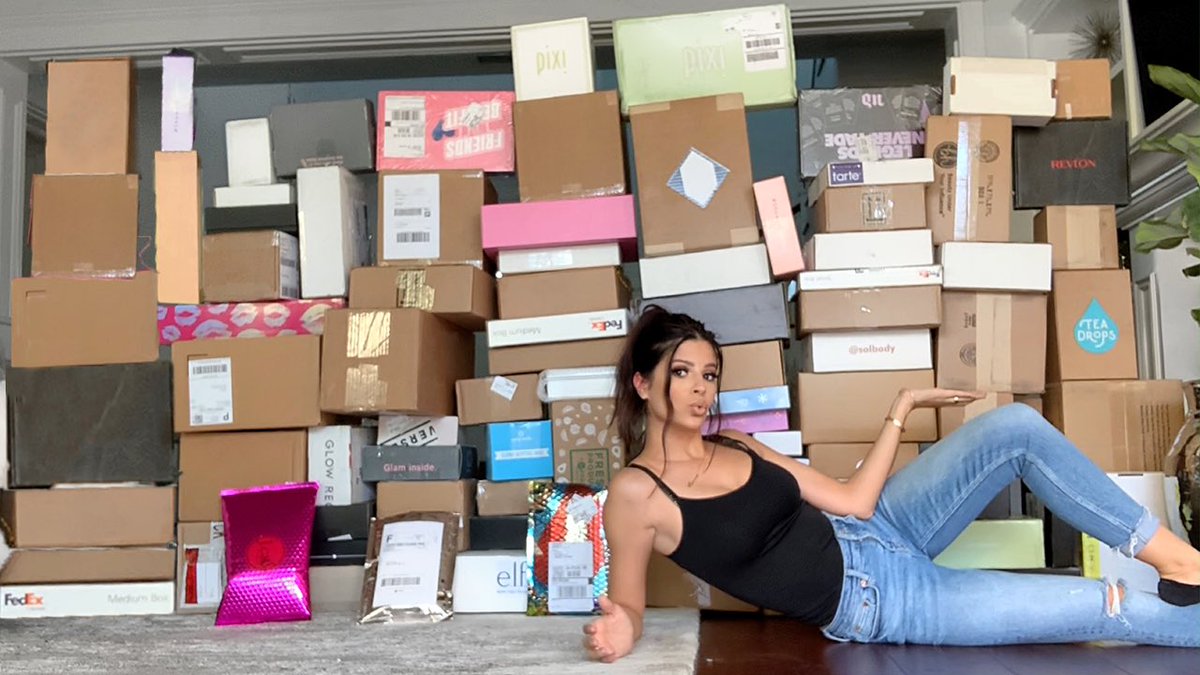A Generation Obsessed: Haul Videos, Flex Culture, And Capitalism

by Charlie Elizabeth Culverhouse
YouTube is crammed with thumbnails of shocked people surrounded by shopping bags. A haul is simply a video in which an influencer shows the large number of purchases they have made within a small amount of time. Hauls are incredibly popular and still on the rise with creators taking to TikTok to share their buys.
The videos are often a useful way for viewers to receive a review of items they are considering spending money on before they shell out and put in an order. With the influx in online shopping from unreliable sites such as AliExpress and even your run of the mill fast fashion sites like BooHoo, it’s hard to assess the quality of an item from its photoshopped pictures. Influencers have the opportunity to share whether a brand is worth a viewers’ hard-earned cash or not – potentially saving their audience time and money.
The setup of haul videos is just as important as the content shown off. They are often done so you feel as though you’re sitting with a friend as they go through their shopping and look to you for approval on their finds. In this sense, it’s comparable to ASMR and offers a facade of social interaction through lonesome times.
Hauls are also a great way to keep audiences up to date with new items and trends, as well as inspire them to step out of their comfort zones and try new things. The videos can be helpful for people struggling to find their style; younger viewers who are just stepping into fashion for example. Influencers with different body types can also offer insight on what clothing best accentuates their features and pass down what they’ve learnt to their fans – the videos offer a roadmap that people in real life might not.
But the road map may be less of a yellow brick road and more of an out of reach, pricey, and sometimes even sketchy high street.
One of the biggest issues surrounding haul videos has been ‘resolved’ by stricter laws. These laws force influencers to state when items have been sent to them or they’ve been paid to talk about them. Before the laws came in, influencers often got paid to talk about an item and encourage their viewers to purchase it without divulging that they were paid to do so. Now, the same thing still happens but at some point in the video, the influencer will mention they have been paid to share the item – the reviews are still good and people are still encouraged to buy the product.
These ads are a go-to marketing technique for many brands who send huge amounts of clothes to people with a platform in return for good reviews – whether they’re true or not. Influencers happily play along, getting new stuff sent to them in return for fooling their audience at worst, and misleading them at best. When an influencer approves a certain trend or item, the likelihood that fans will buy into the idea grows. Fans will join in because they’re following someone they admire and want to, subconsciously or consciously, emulate. These influencer/brand partnerships take advantage of the trust fans hold in influencers to tell the truth and both parties make huge amounts of money.
The sheer number of fashion retailers and makeup brands that exist today, coupled with the volume of haul content being released regularly, audiences are exposed to thousands of pounds worth of products daily. The average haul video can feature anywhere between £200 to £2000 worth of products – and that’s ignoring the ‘luxury hauls’ which can reach five digit figures.
The buying habits of influencers, who earn way more than the average person watching them, are sold as ‘normal’ and are even encouraged. The splurges shared online create but a slight dent in influencer’s bank accounts, when to viewers, the same amount of money could be near life changing. In a society where there is already massive pressure to keep up with a luxurious lifestyle, haul videos can leave viewers feeling inadequate, shamed and left out.

The click-baiting titles of hauls often share the enormous amounts of money the influencer has spent to draw in audiences. This promotes the idea that excess is everything and that you must spend insane amounts of money to be fashionable. You could argue that this ‘flex culture’ is the only reason haul videos exist. There is an elitism attached to social media which allows people to brag about how much they are able to spend – the more money, the better.
Haul content is undoubtedly fuelled by materialism and, as well as selling physical items, promotes the idea that having loads of costly possessions equates to happiness. It’s a wonderful idea that we know is untrue but, as the lines between online and offline blur, that fact can get lost.
In all fairness, we cannot blame haul videos for existing. They are a product of the times in which we live. The line between need and want is continuously blurred. We need food, water, and shelter. We want a new handbag. While the existence of haul videos does drive and promote over consumption, they are simply playing into an already prevalent desire. We are all predispositioned to want more, to think that we absolutely need lots of stuff. Shopping has become an activity, not a foraging spree where we gather only necessities and run back home.
Here it’s impossible not to mention the vicious cycle of capitalism, so let’s sum it up briefly. Companies trick audiences into purchasing through the fear of ‘missing out’. The trick is tried and tested, and always works. This not only affects the buying habits of societies, making them purchase all kinds of products, but perpetuates issues such as climate change and child labour to name just two.
The tactics promote overconsumption because the companies need us continuously purchasing in order for them to make money. If we were encouraged to simply buy what we need, companies would have no need to stay selling. Recently this fact has become common knowledge bringing into question the ethics of haul videos – but it’s tough when nearly everything is controlled by ‘higher ups’ perpetuating the behaviour. Yes, influencers are making the decision to produce and share this content, but the issue is deeply rooted.

Even with the more ‘ethical’ thrifty haul videos, overconsumption is rampant. More people thrifting things they need will fix a problem, more people overconsuming second-hand creates more problems than it solves. A lot of the people making haul videos clearly have money – whether they’re buying from fast fashion brands or charity shops. There isn’t a need for them to be buying cheap clothing – they should be the ones buying from sustainable brands. Most hauls feature unsustainable companies like Primark because they’re affordable; meaning people can buy more and ‘flex’. Lots of people shop fast fashion out of necessity, lower income people are not the ones mass purchasing clothing to show in hauls – because they can’t afford to. If you can afford to splurge at cheap prices, you can solve your overconsumption habits, and keep a clean conscience, by choosing to shop sustainably.
The entire point of a haul is just to say ‘look at all this stuff I bought’, but what happens after the video ends? The ongoing cycle of watching people show off products they’ve purchased leads us to decide we must have it all too. A few weeks go by and there’s a new trend, a new haul, and the cycle repeats. The cycle is not only unsustainable in terms of overconsumption, but it’s impossible for those on the average income to financially support those buying habits.
It’s entirely possible to be on-trend without unnecessary consumption. Buy what you need, buy what you want sustainably. Promoting this idea, instead of flexing in front of people on the internet, is how we win the fight against fast fashion.
So no, I don’t want to see your haul.
Discover more from GUAP’s Fashion section here

